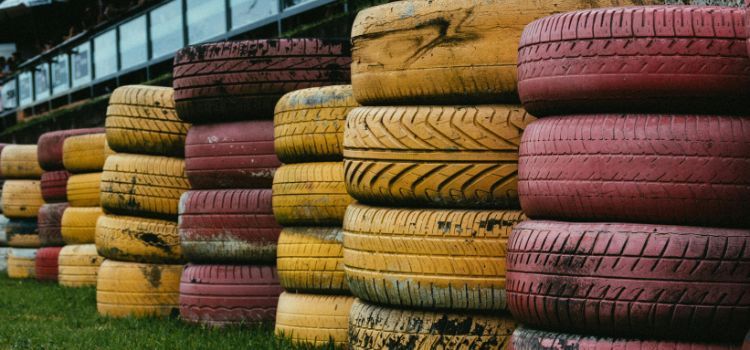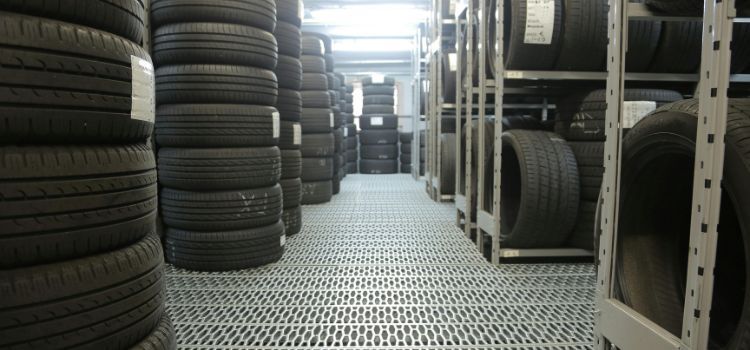Tires are one of the most critical components of your car, affecting its performance, safety, and fuel efficiency. However, buying new tires can be confusing and overwhelming, especially if you don’t know what to look for. That’s why we have prepared this guide to help you ask the right questions when buying tires so you can make the best decision for your vehicle and your budget.

How much tread do I have left?
The first question to ask when buying car tires you should ask yourself before buying tires is how much tread you have left on your current ones. Tread depth is the size of the tire surface grooves that provide traction and grip on the road. The more tread you have, the better your tires can handle wet, snowy, or slippery conditions.
A primary coin you can use to determine the tread depth of tires. Place a quarter, nose down on the caribou, into one of the grooves. Your tread depth is smaller than 4/32 inches if the nose tip is visible, meaning you will soon need new tires. If you can see the entire nose, you need new tires immediately because your tread depth is less than 2/32 inches.

Alternatively, you can utilize a tread depth gauge, a tool that measures the exact depth of the grooves in millimeters. Canada’s lowest legal tread depth is 1.6 mm, but experts recommend replacing your tires when they reach 4 mm.
What is my tire size and vehicle type?
The following questions to ask when buying new tires. You should ask yourself your tire size and vehicle type. Tire size is the combination of numbers and letters on the sidewall of your tire that indicate its dimensions, such as width, aspect ratio, diameter, load index, and speed rating. For instance, a tire size of P215/65R15 95H means:
You can find your tire size either on the sidewall of your tire, on the driver’s door jamb, or in your owner’s manual. Buying tires that match your tire size is essential, as mismatched tires can cause problems with your vehicle’s handling, braking, stability, and fuel economy.

Vehicle type is the category of your vehicle, such as sedan, SUV, pickup truck, minivan, or sports car. Different vehicle types have additional tire requirements depending on weight, power, performance, and driving conditions. For example, SUVs and pickup trucks need tires that can handle heavier loads and off-road terrain, while sports cars need tires that can deliver high-speed performance and cornering grip.
You can find your vehicle type either on your registration papers, on your insurance policy, or in your owner’s manual. Buying tires designed for your vehicle type is essential, as unsuitable tires can compromise your vehicle’s safety, comfort, and efficiency.
What type of tire should I buy?
The third question to ask when buying tires. You should ask yourself what type of tire should you buy. Tire type is the category of tire that indicates its primary purpose and characteristics, such as all-season, summer, winter, all-terrain, or performance. Different tire types have distinct advantages and disadvantages, depending on the weather and road conditions you drive. For example, all-season tires are the most common and versatile type, offering acceptable performance in weather and road conditions. However, they could be better at things and may need to provide more traction and grip in harsh conditions, such as heavy snow or ice.
To choose the right tire type for your vehicle, you should consider the following factors:

Climate:
Your climate affects the temperature and precipitation levels you encounter throughout the year. If you live in a region with mild and moderate weather, you may be OK with all-season tires. However, if you live in an area with harsh and variable weather, you may need to switch between summer and winter tires, depending on the season. Summer tires are optimized for warm and dry conditions, offering superior handling, braking, and fuel efficiency. Winter tires are optimized for cold and snowy conditions, offering enhanced traction, grip, and safety.

Driving style:
Your driving style affects the speed and aggressiveness you drive and the distance and frequency you travel. If you are a casual and conservative driver, you may be satisfied with standard or touring tires, which offer a smooth and quiet ride, good tread life, and reasonable performance. However, suppose you are a spirited and adventurous driver. In that case, you may prefer high-performance or ultra-high-performance tires, which offer a responsive and exhilarating ride, excellent handling, and superior performance. However, these tires also wear out faster, cost more, and are noisier than standard or touring tires.

Driving conditions:
Your driving conditions affect the type and quality of the roads you drive on and the obstacles and challenges you face. If you primarily drive on paved and well-maintained roads, you may not need any particular features or capabilities from your tires. However, if you often drive on unpaved, rough, or uneven roads, you may need all-terrain or mud-terrain tires, which offer extra durability, traction, and puncture resistance. However, these tires also tend to be heavier, louder, and less fuel-efficient than regular tires.
What is the tread life expectancy and mileage warranty on these tires?
The fourth question to ask when buying tires. You should ask yourself is the tread life expectancy and mileage warranty on the tires you are considering. Tread life expectancy is the estimated number of kilometers or miles a tire can last before its tread wears out. A mileage warranty guarantees the tire manufacturer that it will last a certain number of kilometers or miles, or they will replace or prorate it.
Tread life expectancy and mileage warranty are essential factors to consider when buying tires, as they indicate the longevity and value of your investment. However, they are not the only factors, as they can vary depending on the tire type, quality, maintenance, and driving habits. For example, a high-performance tire may have a shorter tread life expectancy and mileage warranty than a standard tire, but it may offer better performance and handling. Similarly, a tire may have an extended tread life expectancy and mileage warranty but perform poorly in wet or snowy conditions.
To compare the tread life expectancy and mileage warranty of different tires, you should look at the Uniform Tire Quality Grading (UTQG) system, which is a rating system developed by the U.S. Department of Transportation (DOT) to provide consumers with information on tire quality and performance. The UTQG system has three ratings: treadwear, traction, and temperature.

Treadwear:
The treadwear rating is a number that indicates how long a tire will last compared to a contact tire with a rating of 100. The higher the number, the longer the tire will last. For instance, A tire with a 200 treadwear ranking will last twice as long as one with a rating of 100. However, the treadwear rating is not an absolute measure of tread life, as it is based on controlled tests and may not reflect real-world conditions. Therefore, using it as a relative measure to compare tires within the same brand and category is best.

Traction:
The traction rating is a letter that indicates how well a tire can stop on wet pavement. The ratings are A.A., A, B, and C, with A.A. being the highest and C being the lowest. The traction rating is based on straight-line braking tests and does not reflect cornering or turning performance. Therefore, using it as a general guide to compare tires within the same category and speed rating is best.

Temperature:
The temperature rating is a letter that demonstrates how well a tire can resist heat buildup. The ratings are A, B, and C, with A being the most elevated and C being the most inferior. The temperature rating is based on high-speed tests and does not reflect normal driving conditions. Therefore, it is best to use it as a minimum requirement to ensure your tire can handle the speed and load of your vehicle.
You can find the UTQG ratings on the sidewall of your tire, on the tire label, or the tire manufacturer’s website. However, it’s essential to note that the industry does not standardize UTQG ratings, and manufacturers may employ different methods and criteria to assign them. Therefore, you should not use them to compare tires from other brands or categories but only as a reference within the same brand and type.

What are the reviews and ratings of these tires?
The fifth question to ask when buying tires. You should ask yourself, what are the reviews and ratings of the tires you are considering? Reviews and ratings are the feedback and opinions of other consumers who have bought and used the tires you are interested in. They can provide valuable information on the tires’ quality, performance, and reliability, as well as their pros and cons, strengths and weaknesses, and advantages and disadvantages.
Reviews and ratings are necessary factors to consider when buying tires, as they can help you verify the claims and promises of the tire manufacturers, as well as identify any potential issues or problems with the tires. However, they are not the only factors, as they can vary depending on the source, quality, and credibility of the reviews and ratings. For example, some reviews and ratings may be biased, inaccurate, outdated, or fake, while others may be honest, reliable, current, or verified.

To find and evaluate the reviews and ratings of different tires, you should look at various sources, such as online platforms, magazines, websites, blogs, forums, or social media. It would help if you also looked at the number, date, rating of the reviews and ratings and the reviewers’ and raters’ details, comments, and feedback. You should also compare and contrast the reviews and ratings of different tires and the reviews and ratings of the exact tire from other sources.
However, it would help if you remembered that the reviews and ratings are not objective or definitive measures of tire quality or performance but somewhat subjective and personal opinions of individual consumers. Therefore, you should not rely on them solely or unthinkingly but use them as a supplement or reference to your research and judgment.

Conclusion
Buying new tires can be daunting and complicated, but it doesn’t have to be. By asking yourself these five questions when buying car tires, you can simplify and streamline the process and make the best choice for your vehicle and your needs. Remember, the right tires can make a big difference in your car’s performance, safety, and efficiency, so don’t settle for anything less than the best. Happy driving!
As an Amazon Associate, we get a commission from qualifying purchases. However, we recommend based on our genuine opinions and experiences, and We only recommend products and services that we believe will be helpful and valuable to you.